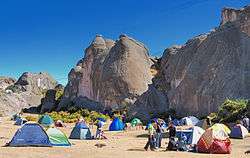Marcahuasi

Marcahuasi (Spanish pronunciation: [maɾkaˈwasi]) is a plateau in the Andes Mountains, located east of Lima, on the mountain range that rises to the right bank of the Rímac River. This mountain range dominates the landscape at 4,000 m above sea level and the place is known for curious shapes of human faces and animals visible in granite rock.
Discovery
The place was first investigated by Daniel Ruzo during the 1950s and in an area of about 3 km2, several hundred curious shapes are found, which can be presumed as natural formations.[1] The place is located at a height of about 12500 feet in the Andes Mountain.[2]
Features
The plateau originated from a volcanic reaction. It is about 4 square kilometers in area, and is located almost 4,000 meters high in Huarochirí Province, east of Lima, Peru. Marcahuasi is home to a unique set of huge granite rocks with curious shapes resembling human faces, animals, and religious symbols. There are many theories as to their origins, including the assertion that their unusual shapes formed naturally through erosion. Some argued that they are sculptures shaped by ancient people but archaeologists clearly state that the shapes are the result of erosion over centuries. There are some small pre-Columbian structures, which are tombs of ancient people and some of which are robbed and vandalised.[3]
There is also a collection of ruins on the north side of the plateau. Over 50 structures still stand in varying states of decay. The doorways are very small, some three feet high. Most of the structures are narrow since the use of arches was not known, therefore spans had to be covered with suitable rock that may have been quarried locally. There are also what appear to be burial tombs on the outskirts of the settlement.
Shapes
A huge granite human head staring at the sky resembles the face on mars.[1] There is another human head shape called the Incas head by Daniel Ruzo, the first person to investigate the rocks for months during the 1950s. Rock formations resembling human chins and mouths are found abundantly.[1] Adventurers and explorers have given various names to the rock shapes based on resemblance and such names include The Camel, Frog, Sphynx, Monument of Humanity (Peca Gasha), fortress, The Alchemist Tortoise etc.[4]
Gallery
-

The Fortress of Marcahuasi
-

Another view, with the camping zone
-

The high lands and the road to the plateau
See also
- Badlands Guardian a feature that from the air bears a strong resemblance to a human head wearing a full Native American headdress
- 'Face on Mars', photographed by Viking 1 in 1976
- Old Man of the Mountain, rock profile in New Hampshire
- Old Man of Hoy a rock pillar off Scotland that resembles a standing man
- Pareidolia, the phenomena of perceiving faces in random patterns
- Marcahuasi (Markawasi) Stone Forest, Lima, Peru on Google Maps
References
- 1 2 3 Carlotto, Mark. The Cydonia Controversy (2008 ed.). Lulu.com. p. 170,171. ISBN 9781435755796. Retrieved 5 October 2014.
- ↑ "The Mysterious Stone Monuments of Markawasi Peru". bcvidio. B C Video. Retrieved 5 October 2014.
- ↑ Schoch, Dr. Robert M. "The Mystery of Markawasi" (2005 ed.). Circular Times. Retrieved 9 October 2014.
- ↑ "Markawasi Stone Forest in Peru: Marcahuasi Stone Garden figures". exploeres journal. Retrieved 8 October 2014.
Bibliography
- Mazzotti Lopez, Daniel (2001). A mochila en Perú (Backpacking in Peru) Peruvian explorers.
- Video: Marcahuasi: Enigmatic Stones in the Peruvian Andes
- Doore, Kathy (2008), Markawasi: Peru's Inexplicable Stone Forest
- Williamson, George Hunt (1973), Road in the Sky
Coordinates: 11°47′20″S 76°34′25″W / 11.78889°S 76.57361°W